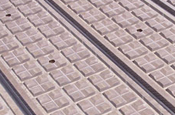
|
VACUUM GRIDED TABLEScnc router vacuum table with matrix of grooves The initial introduction of CNC technology into the woodworking industry was focused on rapid cutting of full sheets, MDF, Hardwood Plywood and Veneer Core. It was used extensively for kitchen cabinet boxes and doors. Creative woodworkers realizing the potential of CNC routers expanded their roll in the wood industry to cutting all kinds of solid wood components. The one piece flow-through vacuum table top just did NOT work in these applications, so some innovative types worked hard to create some cnc vacuum hold down devices that were more flexible. This was the birth of zoned or grided tables and vacuum pods or cups. Vacuum Grids:
The slots across the X and Y axis allow you to take gasketing material and corden off limited sections of the table, to contain the vacuum to that part of the table in use.
The biggest disadvantage of these tables is that you risk damaging the main table in any applications where you need access to the edge of your work. To address this and extend the flexibility of the grids incorporated into the modern vacuum tables a number of manufacturers have come up with designs for Vacuum Pods so keep reading >>
|
|
 Have a look at the picture to the right. This is a Techno Vacuum Table Grid. It is sulptured out of an aluminum sheet with holes to bring the vacumm up to the surface, spaced every few inches.
Have a look at the picture to the right. This is a Techno Vacuum Table Grid. It is sulptured out of an aluminum sheet with holes to bring the vacumm up to the surface, spaced every few inches.